1lumen selects and reviews products personally. We may earn affiliate commissions through our links, which help support our testing.
Thrunite T2 review
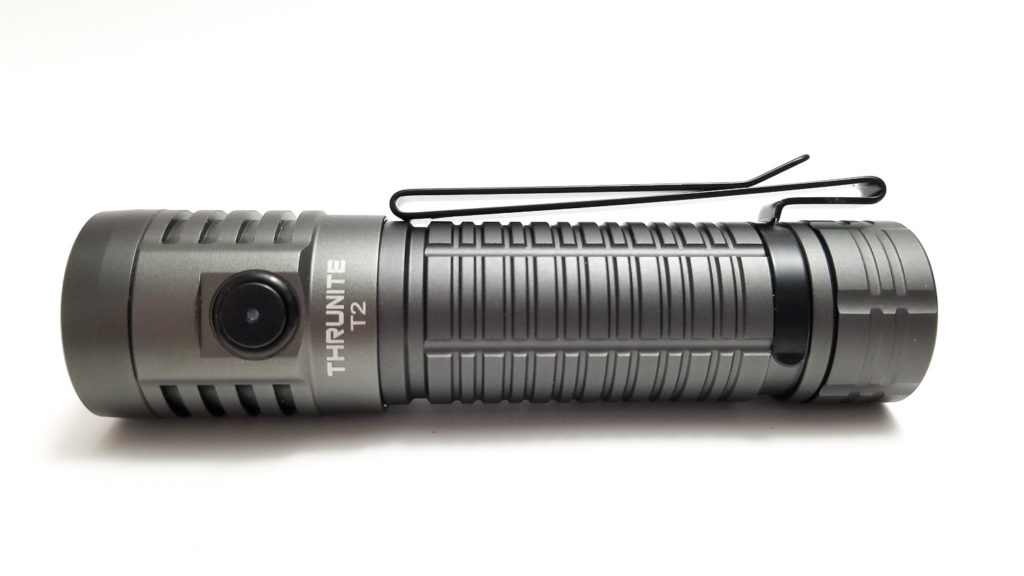
Thrunite T2 specifications
| Brand/model | Thrunite T2 |
|---|---|
| Category | EDC flashlight |
| LED | CREE XHP70.2 |
| Max. Lumens | 3757 lm |
| Max. Beam intensity / distance | 6,300 cd |
| Battery config. | 1*21700 |
| Onboard charging | USB-C |
| Modes | 5 |
| Blinkies | Strobe |
| Reflector | OP |
| Waterproof | IPX8 |
| Review date | March 2022 |
Introduction:
Thrunite has become a familiar face here at 1Lumen, and not surprising since they’re a pretty popular brand and have brought the flashoholic and regular consumer market some great lights. I’ve reviewed 5 Thrunite products to date, and I came away impressed each time with their combination of performance and value. You get a solid light with premium features without dipping into your kid’s college fund (or selling a body part). They were nice enough to send out their compact, XHP70.2 EDC light, the T2. Introduced in 2020, it’s not new and hasn’t changed much over its lifespan. It’s basically a scaled-up version of the 18350 size T1 (and T1S), but aside from being only a little larger than the T1S, the T2 is quite a bit brighter, throws farther, and benefits from a 21700-size battery. It features the usual pleasantries like onboard USB type C charging, a well thought-out UI, and the typical value-for-money we all expect from Thrunite. I’m a sucker for anything with an XHP70.2, so let’s get to it.
Package quality.
Thrunite’s packaging can best be described as a slightly more elegant and embellished variation on Convoy or Astrolux packaging. It’s made from sturdy, plain recycled cardboard with product details, a spec sticker, and some feature blurbs. That’s about it, and that’s fine with me. Short and to the point. The box top lifts off and inside, it’s typical-Thrunite, with the light wrapped in plastic nestled in foam with the accessories underneath. Here’s what’s inside:
- Thrunite T2
- Thrunite 5000 mAh 21700 battery (mounted in the light)
- 2 Spare o-rings
- Pocket clip
- Lanyard
- Manual
- Spare charge port cover
- Holster
- USB A to C charging cable
As usual, Thrunite includes their very comprehensive kit, something mirrored across their product line. It’s great for a first-time buyer, who doesn’t need to make additional purchases (li-ion charger, batteries) to get up and going. It’s a great way to market to enthusiasts and professional-users alike. The accessories? Good quality as usual with a nice lanyard and decent USB cable, with some nice extras like a spare charge port cover. The battery is a high-quality 5000 mAh unit and comes charged to 3.7 volts, which is ideal for long-term storage. The light was mechanically locked out for transport.
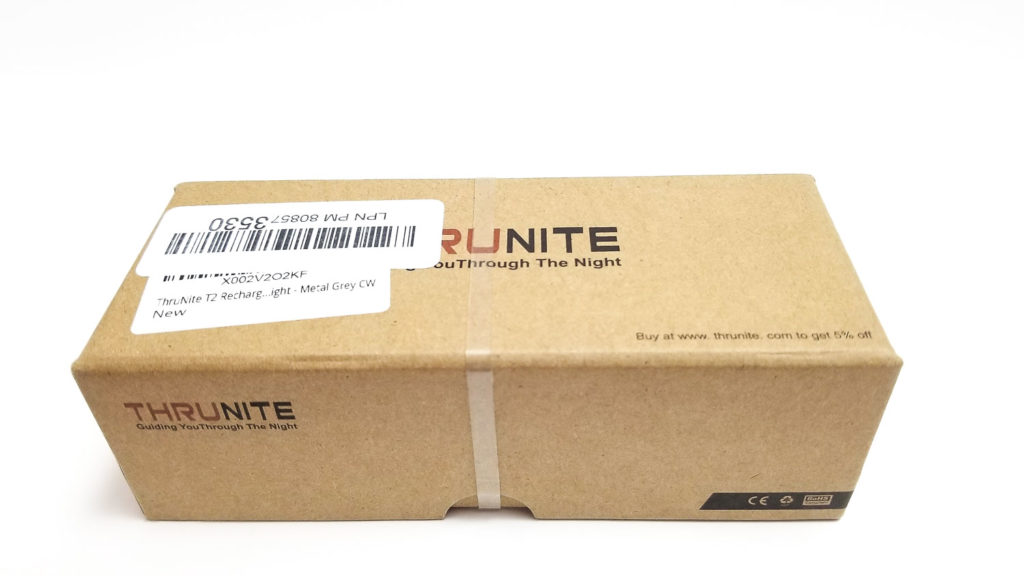
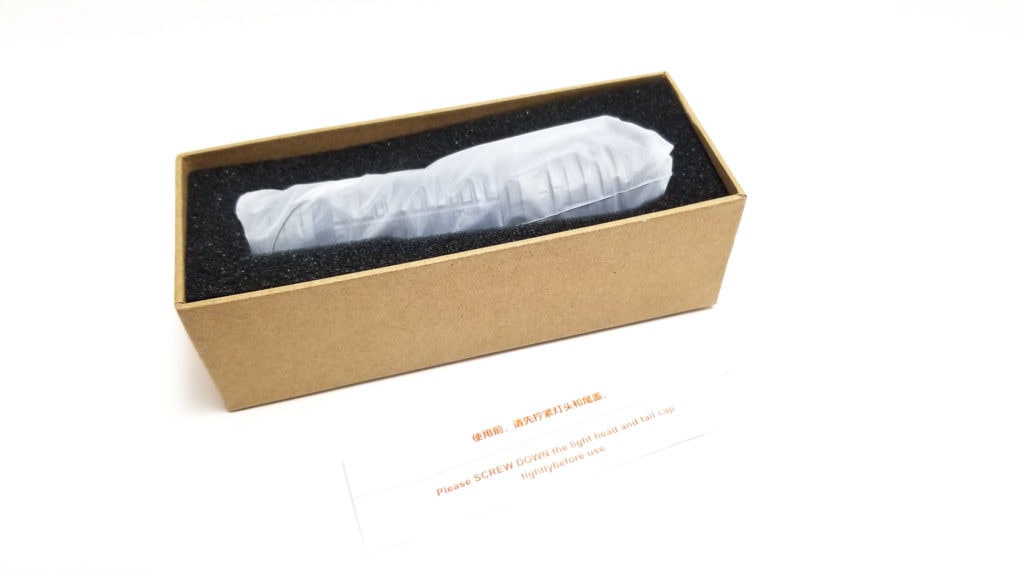
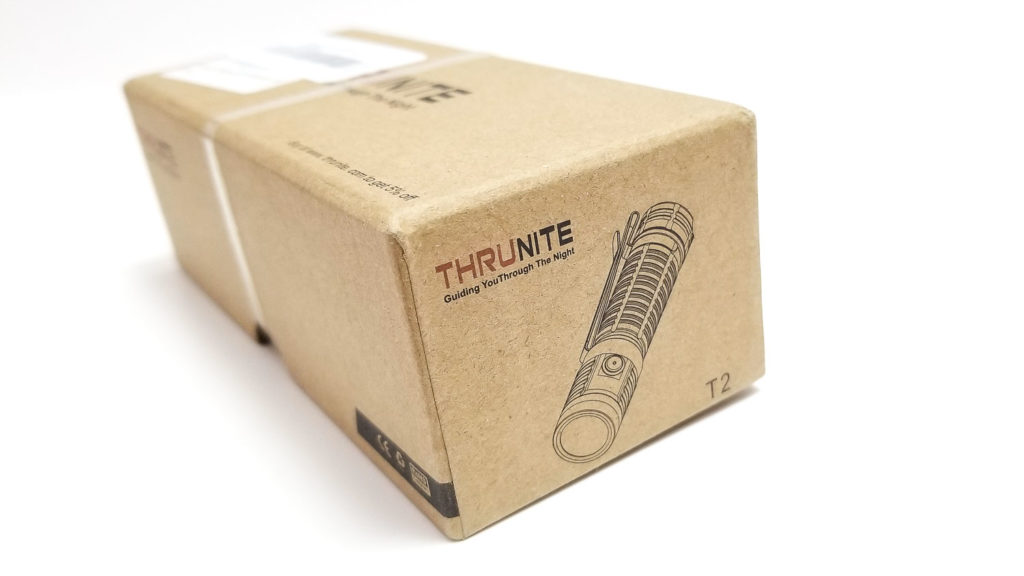
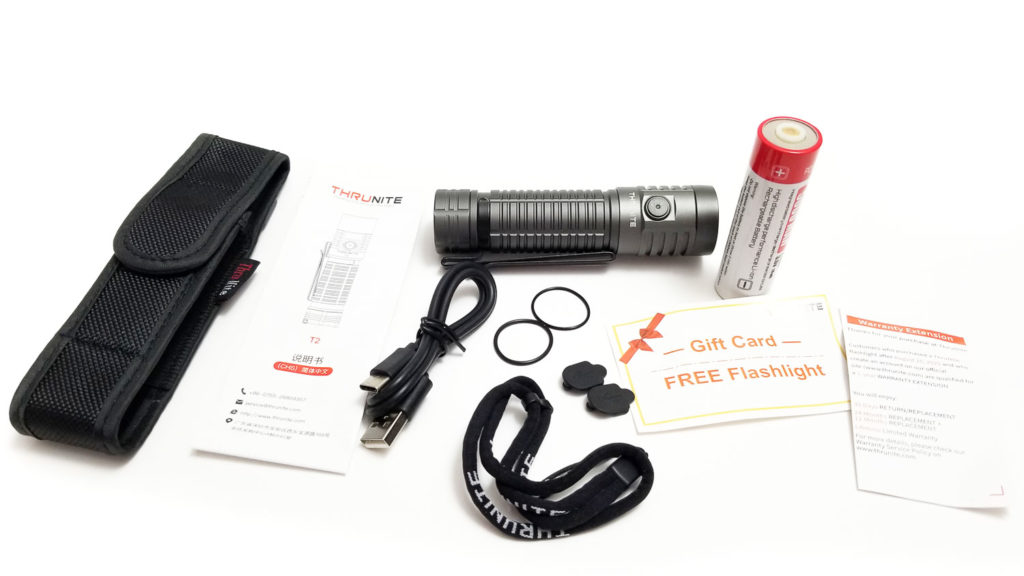
Flashlight in use
The first time I handled the T2, I was impressed with the compact size and lightweight. Remember, this is an XHP70.2 light with a 21700 onboard. It’s closer in size and weight to an 18650 light, but has a nice heft. The tube is properly-sized and would fit a variety of hand sizes. There’s no knurling, but the body of the light is extra grippy thanks to grooves and channels. The tailcap has similar texturing for grip as well.
There’s a single e-switch about 1 inch behind the bezel, and I like this one quite a lot. It’s blacked-out metal of some kind, and the button sits about 2 mm off the equally-black switch bezel. It’s nicely weighted with a soft, but not mushy, click action and great feedback. The characteristic switch LED is present here, and it shows battery state, but only for a few seconds after turn on or for LVP notification.
There’s a charge port set forward and opposite the switch, so while I’d like to see a continuously-lit switch LED, the switch feels different enough from the charge port cover that you won’t necessarily mistake it for one or the other. The (easily!) removable deep carry pocket clip is a dual-position unit, so the light can be pocket carried bezel-up or down, or you can affix the light to the bill of a cap, your sleeve (although it’s a bit portly for that), webgear, battle rattle, or what have you. In the bezel-down position, it sits pretty deeply in the pocket, but I don’t like how the clip extends out over the tailcap. It means less space to get a grip on it, and if you have fat fingers like me, removing the tailcap is a bit clumsy. Unlike the T1, there’s no magnet in the tailcap (which I prefer), but there is a lanyard hole, but alas, once again, it’s woefully too small and forget about threading the lanyard without a tool.
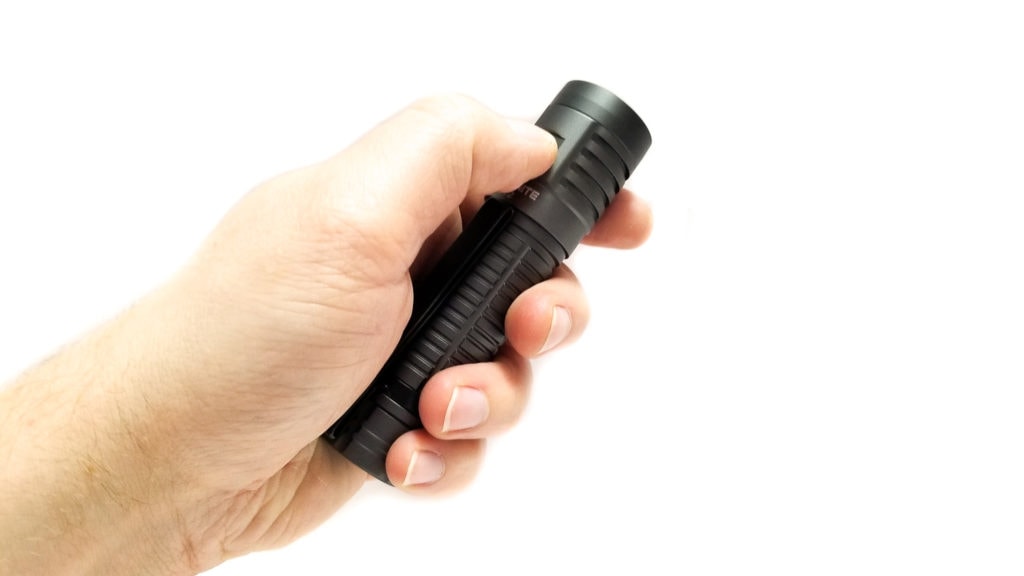
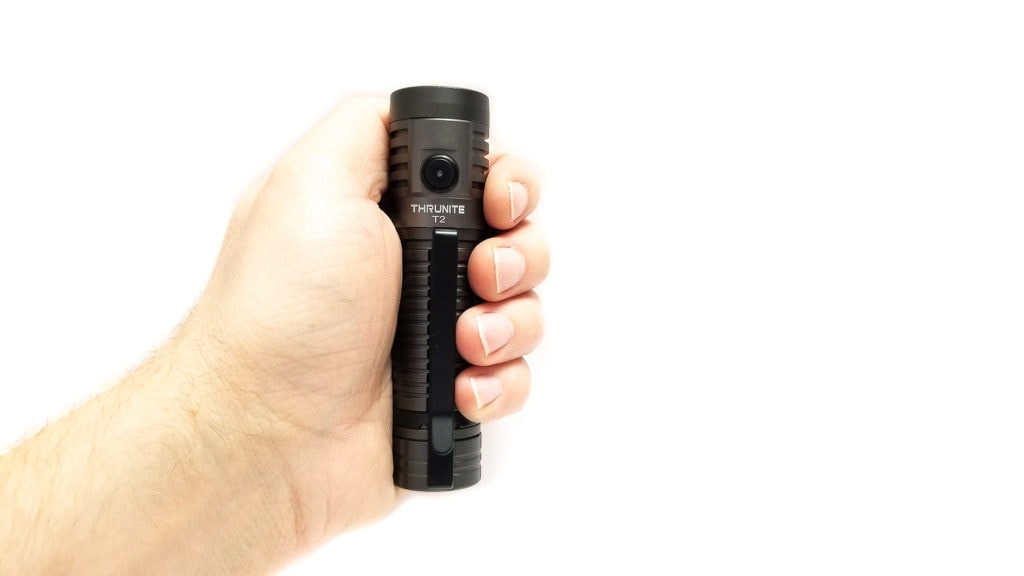
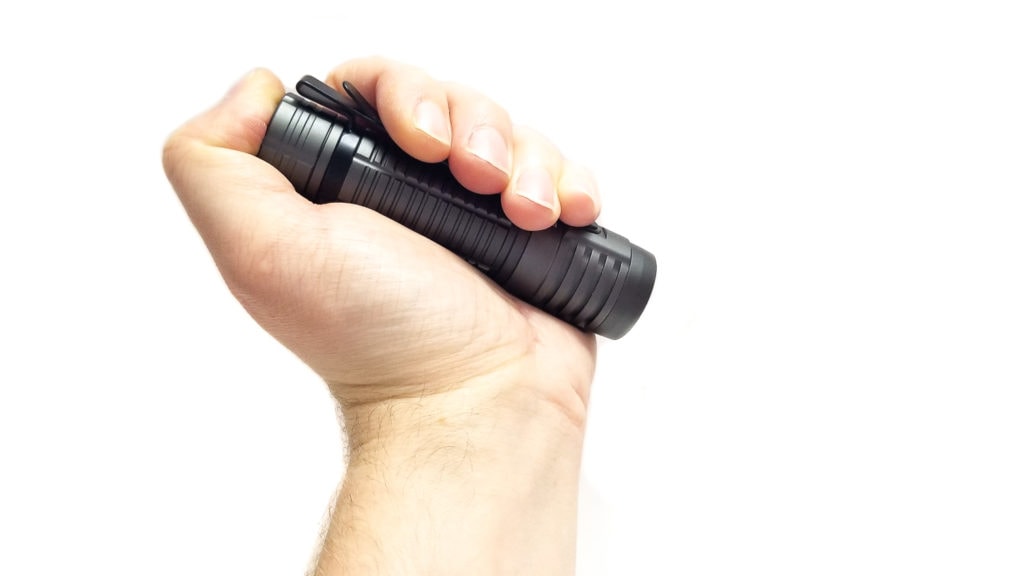
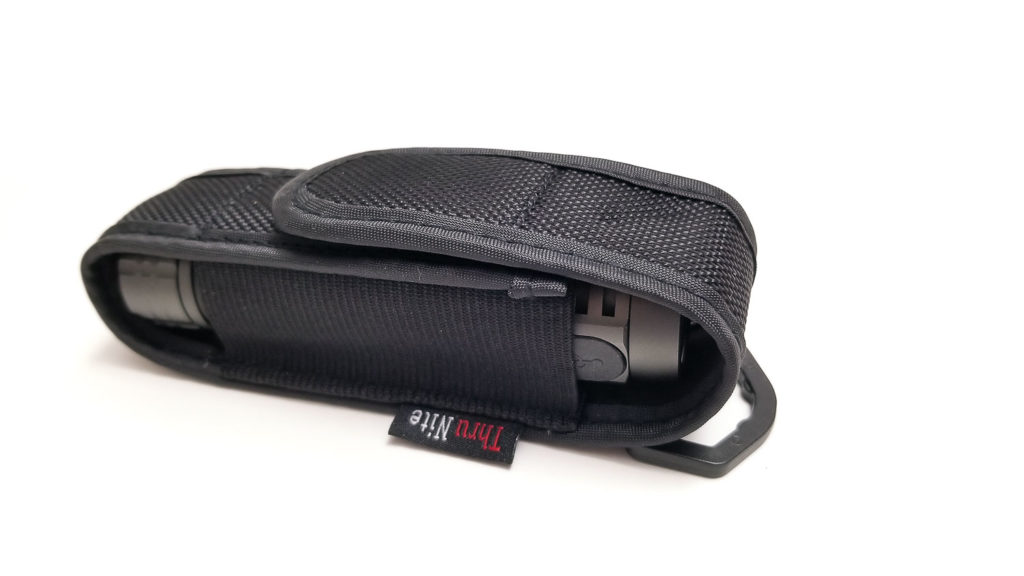
Build Quality, and Warranty
Like my other Thrunite products, the T2 is well made. It’s a recurring theme for Thrunite, and their lights represent a really great value for what you get. For around $60-70 US, you get a lot for a little, especially these days when a tank of gas runs $50. Milled from 6061 T6 aluminum, the machining quality is nice and tidy, with no tool or machine marks, and everything fits together with no gaps or parts that don’t line up. Sharp edges? Not really, but there was an abrupt edge on the lanyard hole. The anodizing is the typical type III HA in a nicely-matte finish. The T2 can be had in black, ocean blue, desert tan, or space gray, (the test light is gray) and the finish is really, really nice, reminiscent of the Thrunite BSS V4 I tested a while back. It’s pretty grippy and was imperfection-free with excellent coverage and sharp silkscreen text.
The light breaks down into three parts: Head, battery tube, and tailcap. I couldn’t remove the bezel with brute strength and meat wrenches (hands) so it’s been given the glue treatment. Each joint is sealed with a decent-sized o-ring, and they are lightly lubed. The front and rear threads are precisely rectangular cut. The rears are bare, but the front threads are fully anodized, save for a small lip, but the light can still be locked out mechanically by unscrewing the head slightly. The rear tail spring is adequately thick and should easily handle the current demands. The driver omits a spring for a solid brass contact. Thrunite gives the T2 an IPX8 rating (although not a proper IP rating, mind you), for up to 2 meters of temporary submersion.
Thrunite’s warranty is a good one and should cover the light for a good, long time. From the Thrunite site: 30 Days RETURN/REPLACEMENT: Any item sold by thrunite.com/ThruNite Direct at Amazon Stores can be returned to get refund within 30 days of receipt in new condition(means the intact condition for secondary offering) with all included accessories, manuals, warranty card(if any), and combo items if you don’t like it. If anything is missing, a fee of 15% of the order or higher (at our discretion) may be charged. The freight caused in return will be paid by the customer. Any item sold by thrunite.com/ThruNite Direct at Amazon Stores can be returned to get refund or replaced within 30 days of receipt if it is defective. 24 Months REPLACEMENT: Any product(not battery) sold by thrunite.com/ThruNite Direct at Amazon Stores which is found to be defective under normal use and service within 24 months and more than 30 days counting from the date of purchasing with proof of purchase(eg: order ID) can be replaced with new ones. Lifetime Limited Warranty: For items purchased after 24 months, we will still provide warranty service, but the cost of the parts and freight(both ways) will be paid by the customers.
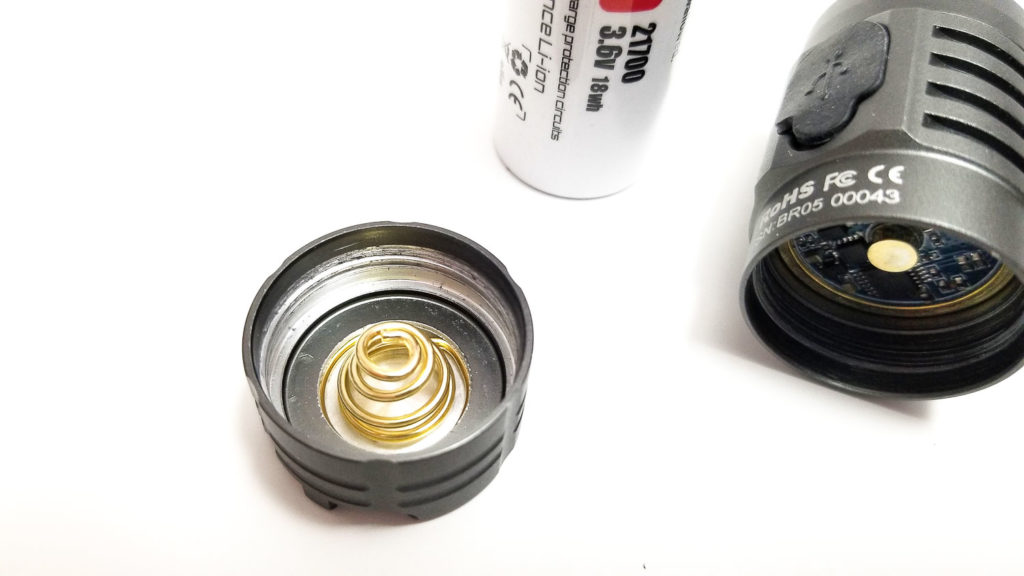
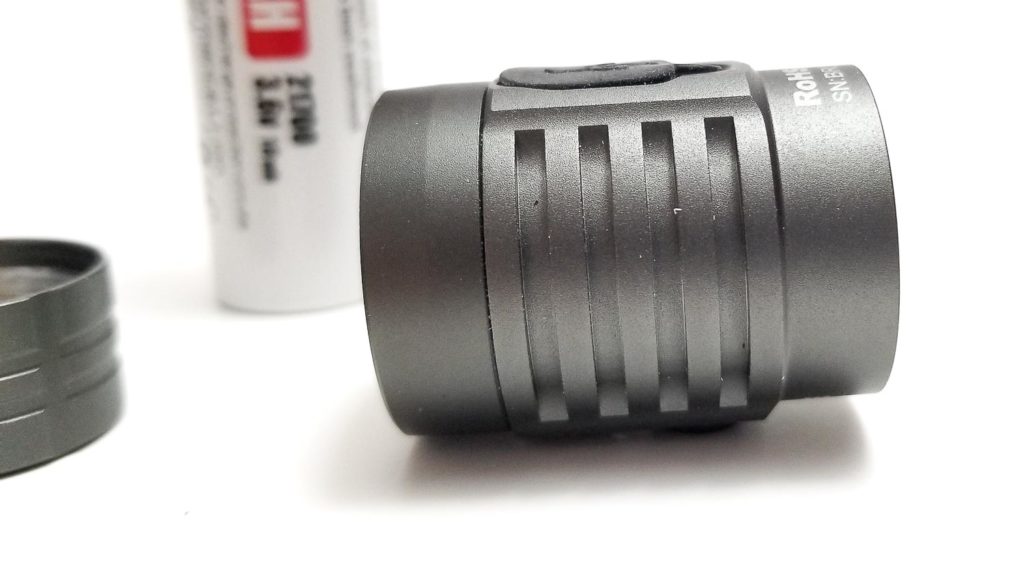
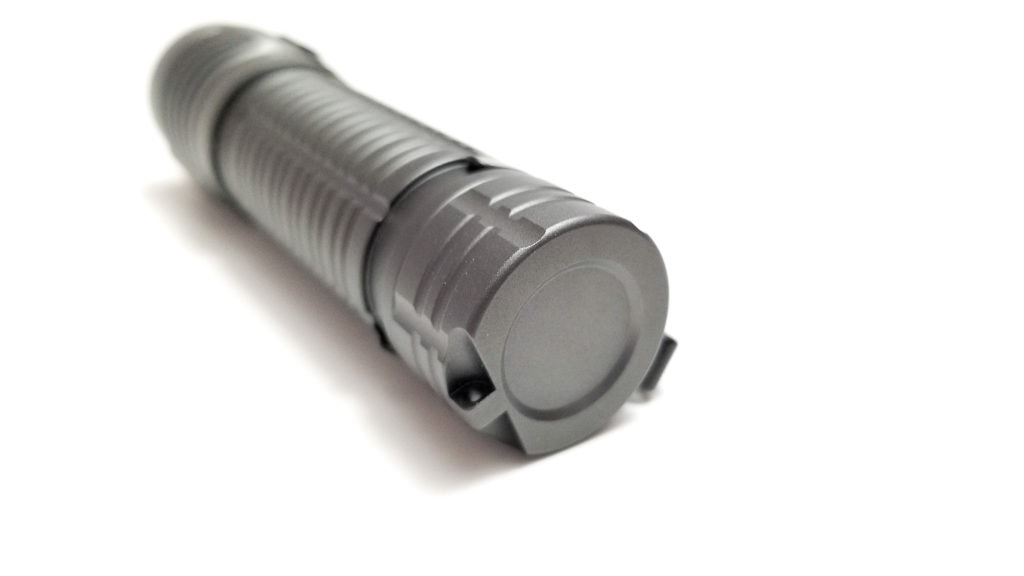
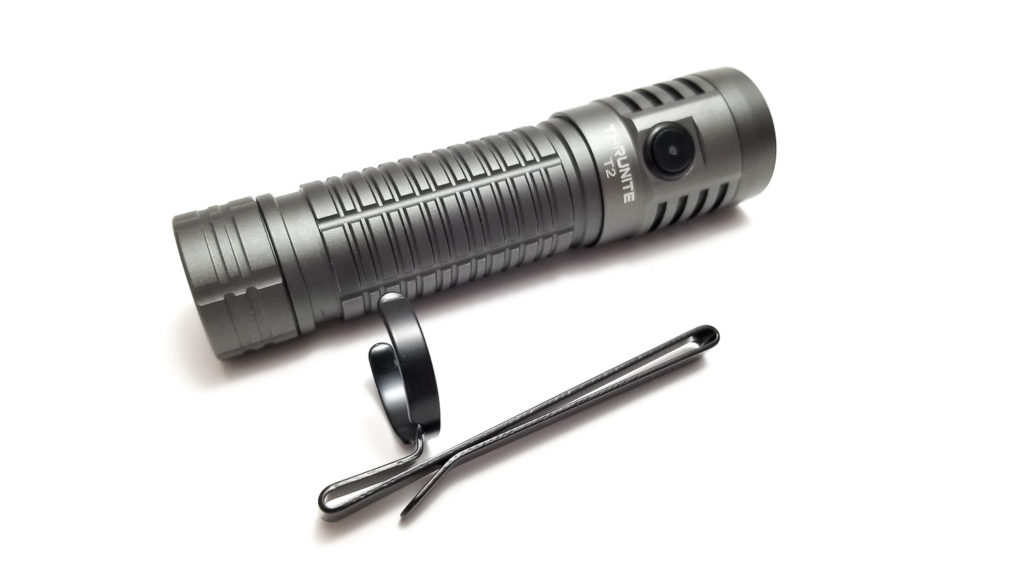
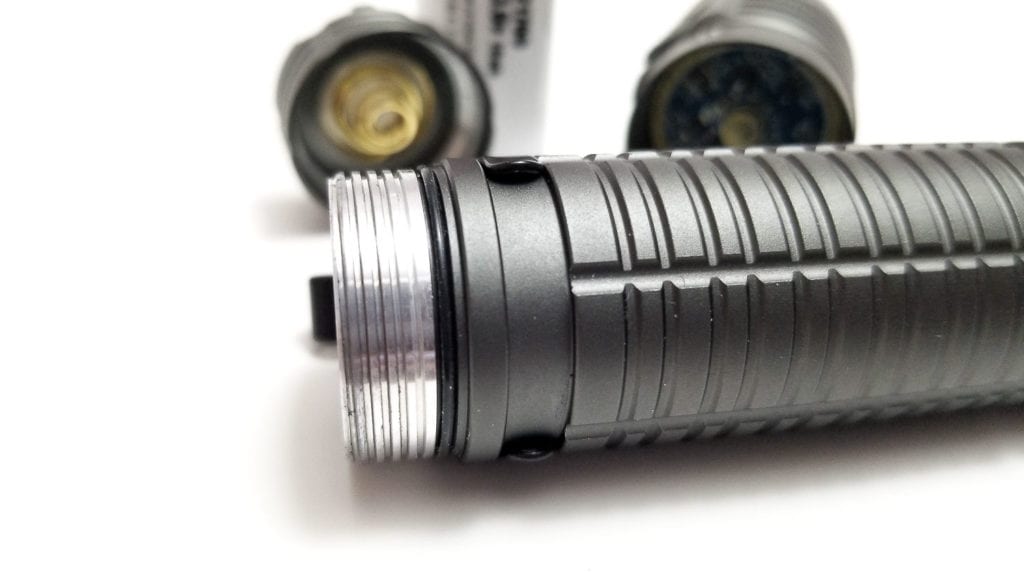
LED, Lens, Bezel, Beam, and Reflector
The T2 comes with Cree’s XHP70.2 emitter. This LED is a common go-to for high output lights, so I’m not surprised to see it featured in the T2 since this light is capable of some serious output. The T2 can be had with the neutral or cool white tints, however the neutral white versions are sold out. The test light came with the cool white variant. XHP70.2 is part of Cree’s XHP line of high performance white emitters, and features a quad die arrangement on a single 7x7mm substrate (7070 footprint). These 6 or 12 volt emitters, and they are domed flip chips with no exposed bond wires. The entirety of the substrate is covered in phosphor, and characteristic of this design, you will get less-than idyllic beam performance riddled with angular tint shift and a yellow corona. The upside is that if properly cooled, they can develop extremely high output while being very efficient at moderate drive currents. I can’t get the bezel off to confirm, but rumor has it that this is a 12 volt XHP70.2, not the usual 6 volt configuration. There’s no real benefit vs. the 6 volt variant, other than a lower drive current.
The bezel on my sample is the same color as the body, but the black light has a silver bezel. It’s smooth on the front, and the AR coated mineral glass lens is recessed about 2 mm to protect it from a front-first rendezvous with the ground. There’s a very shallow OP reflector to help with cleaning up the beam, and this, combined with the extra-floody 70.2 means you get tons of flood. There is a very diffuse hotspot and you get a huge wall of light, making for a very useful beam. The Opple Lightmaster 3 showed the CCT around 7000-7400K on High mode with a CRI of 72 and the duv value is -0.0005.
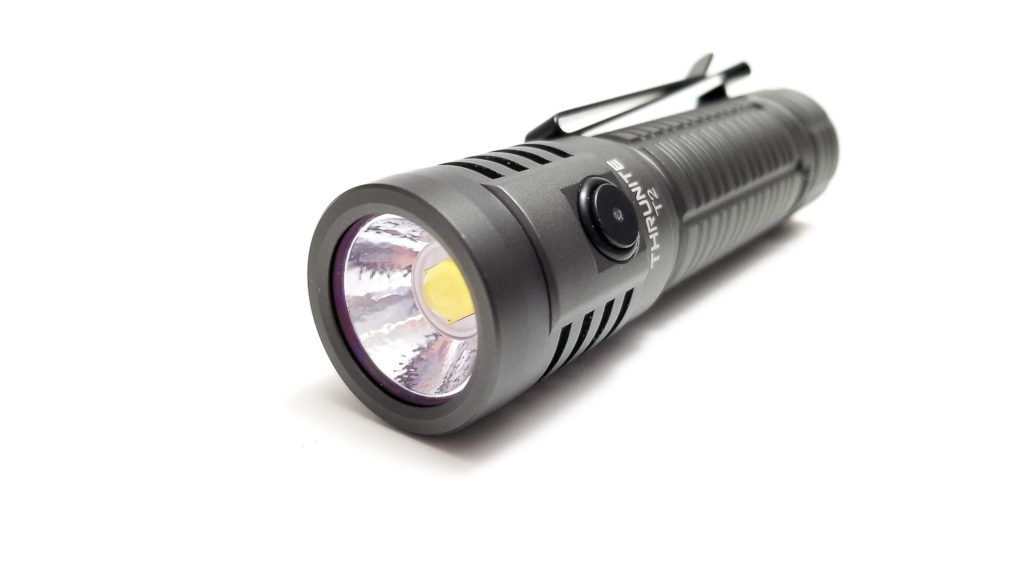
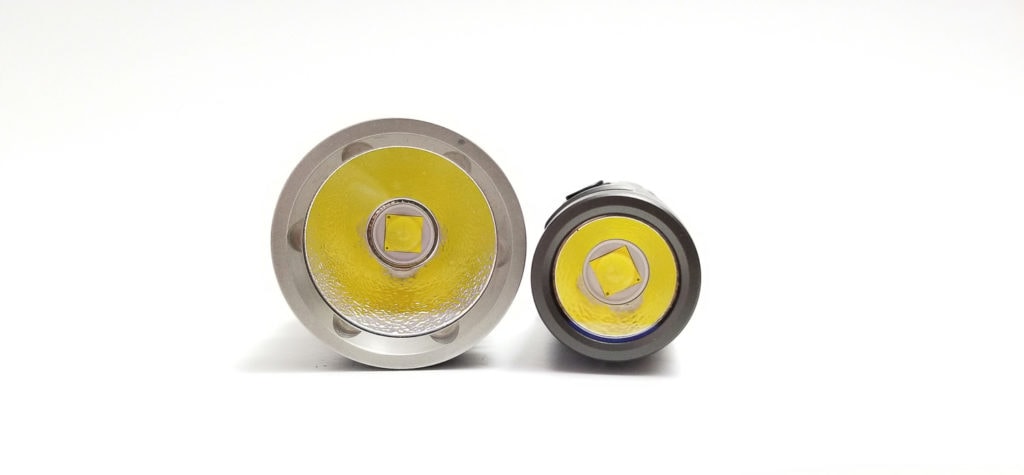
Dimensions and size comparison
- Length: 11.2 cm / 4.4 inches
- Body diameter: 2.6 cm / 1.02 inches
- Head diameter: 3.0 cm / 1.18 inches
Weight:
- Without cell: 79.9 grams / 2.81 oz.
- With included cell:132.7 grams / 4.68 oz.
Flashlight comparison
The T2 V3 is pretty compact for an XHP70.2 light.
Group 1: Thrunite flashlights: left to right: Thrunite TC20 V2, Thrunite T2, Thrunite TC15 V3, Thrunite BSS V4.
Group 2 left to right: Thrunite BSS V4, Thrunite Archer 2A V3, Thrunite T2, Thrunite TC20 V2, Thrunite TN50
Group 3 left to right: Astrolux MF01 Mini, Thrunite T2, Fireflies E07 2021 Edition, Astrolux EA01
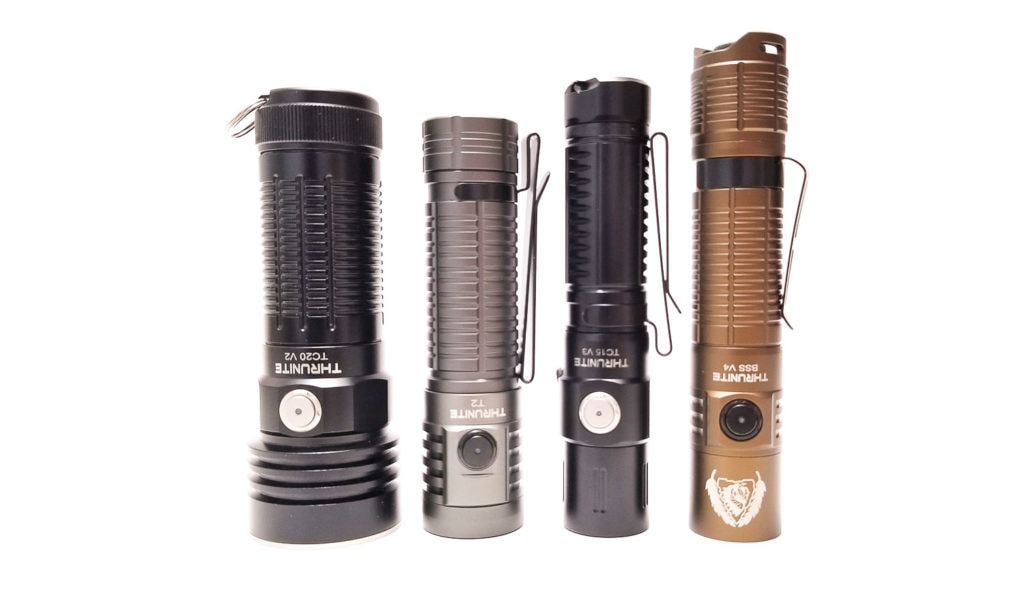
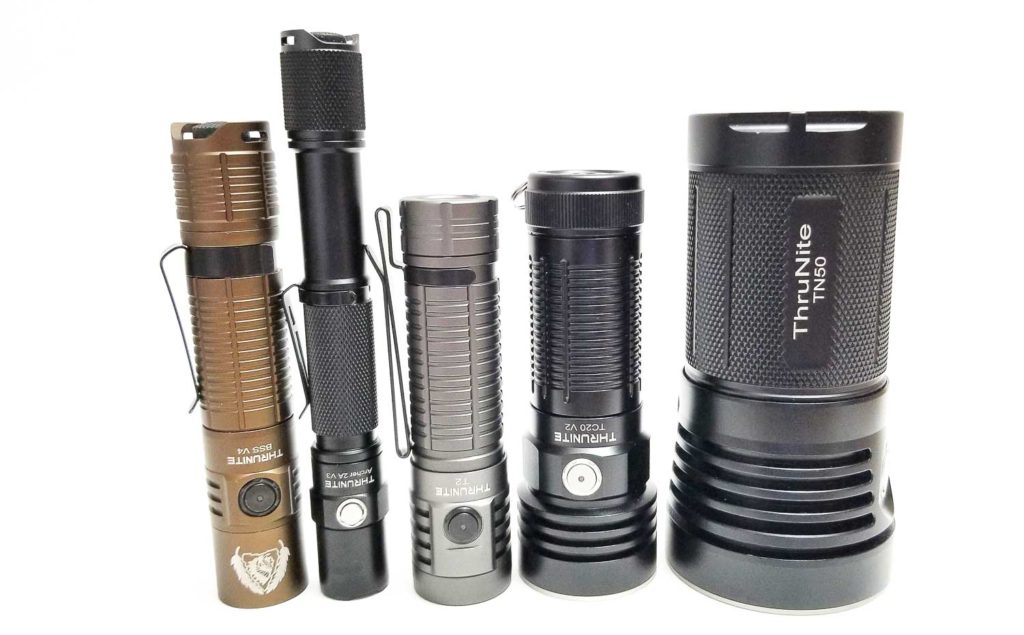
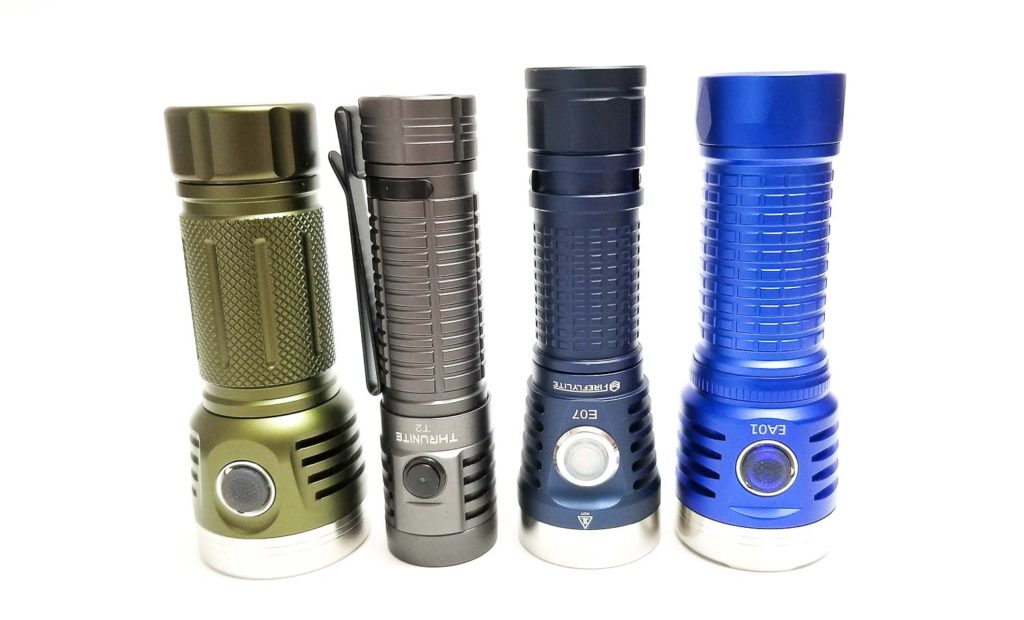
Driver & User Interface:
Since the T2 is a single cell configuration, it’s going to feature a boost driver to boost the 4.2 volts from the battery, and I love these drivers because they offer linear, regulated output that doesn’t change as the battery drains. Like every Thrunite I’ve tested, the T2 features a simple UI, and I’m glad it does after testing the SP36 Pro Anduril2 light my complicatedui-itis was flaring up.
The UI has 5 modes, including Turbo, a Firefly mode, and a single Strobe. Yep, easy. The only shortcut is a double-click for Turbo, press and hold for Firefly, and triple-click for Strobe, and the UI includes niceties like electronic lockout..
Available modes: Firefly, Low, Medium, High, Turbo, Strobe.
From OFF:
- Press and hold: Firefly
- Single click: Turns on in last mode
- Double click: Turbo
- Triple click: Strobe
From ON:
- Single click: Turns off
- Press and hold: Switches between modes L-M-H-L
- Double click: Turbo
- Triple click: Strobe
- Quad click: Defaults to Strobe
Mode memory:
- Yes, recalls last used mode for all modes except Strobe, Firefly, and Turbo
Shortcuts:
- Press and hold from off activates Firefly mode. Double-click in any mode for Turbo, and triple click for Strobe.
Low voltage warning:
- The switch indicator shows battery status, but nothing is mentioned about a visual LVP notification, but the switch LED is blue for >90% to 20%, red 20% to 11%, and flashing red 10% down to 1%.
Strobe/blinkies
- Single Strobe
Lock-out mode:
- Lockout is accessed after activating Firefly mode, releasing the button, and pressing again for 2 seconds. Repeat to unlock. The switch LED will blink red if you press the button when locked. The light can also be locked out by unscrewing the the head 1/8th turn
PWM
- None
Additional info on the UI:
- I like the UI a lot, and it’s sporting the essential features with not much else. The mode spacing is good as well. If you own other Thrunite lights, it will be familiar because nearly identical UIs are present on the Thrunite TC20 V2, TC15 V3, and BSS V4. It’s easy to use and learn as well, and this is great for inexperienced flashlight users, but I think enthusiasts will enjoy it as well. There’s no mention of thermal regulation, but I’m sure it’s there somewhere since on Turbo, the 70.2 can get angry hot quick. One thing I noticed was when engaging Turbo, there’s a slight ‘pause’ before it kicks in when on, and from off, the light starts in what looks like Medium before Turbo activates. Thrunite says there’s intelligent temperature control present, and there usually is. The mode spacing is also good, the Firefly mode is decently dim, and although I’d like a little faster mode switching, it’s not bad.
Batteries & Charging
The T2 uses a 21700 size li-ion cell, and the light came with a Thrunite-branded 5000 mAh 21700. Now, to my surprise, Thrunite decided to go with a ‘customized’ cell, AKA proprietary, with the positive and negative contacts on the top of the cell. This means you can’t use it in another light. However, you can use a non-proprietary cell in the T2. Hmmm (pause for contemplative chin scratching). That’s great on one hand, but it kind of negates the purpose of using a proprietary cell because the goal is to keep the user from using ‘banned’ cells that could potentially damage the light (or the user). I’ll take it though, since it adds flexibility in the event you need swap batteries for some reason.
However, you are stuck with longer cells, as my standard flat top 21700s were too short, and an Acebeam extra-long protected 21700 with USB charging was too long. However, the T2 happily digested my Fenix 5000 mAh protected button tops, and even accommodated Olight’s ORB217C50, another ‘customized’ battery. I tried the Thrunite cell in the Olight Odin and it worked, and, because why not, I tried the similar-looking Imalent MRB-217P40 proprietary cell in the T2. It worked, and lo and behold, the T2’s cell fit in the Imalent R30C. For giggles, I tried the Thrunite battery in the Convoy M21B, and yep, it worked in there also. Hmmm…maybe we need to redefine the term ‘proprietary?’
You get onboard USB type C charging on the T2, and it’s pretty standard at 2 amps. On a 2.1 amp charger I saw a max of 1.99 to 2.07 amps on the USB tester. This isn’t rapid charging but will charge the 5000 mAh cell in about 3 hours. The switch LED lights up red during charging and turns blue when finished. If there’s a fault, it turns purple. The light can be powered over USB with or without the battery, but only Low mode is available. That high charge current generated a bit of heat during charging, so much so I shot it with my infrared thermometer and it came in at 41 C.
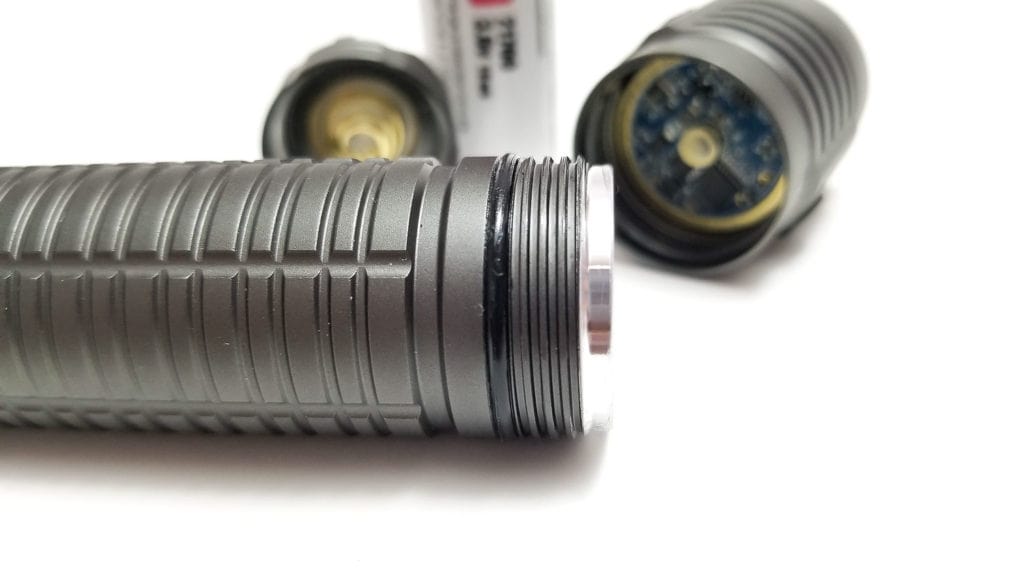
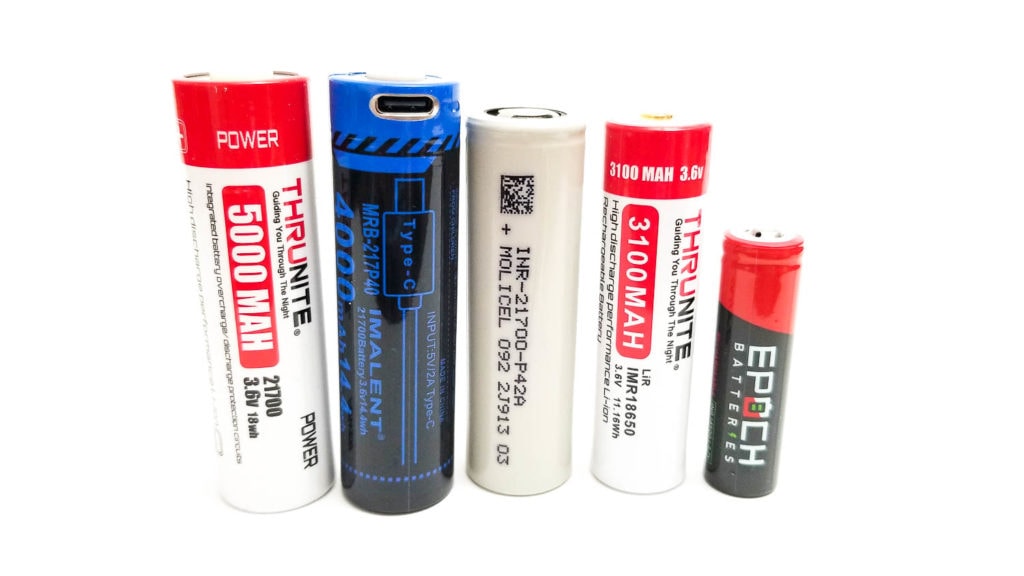
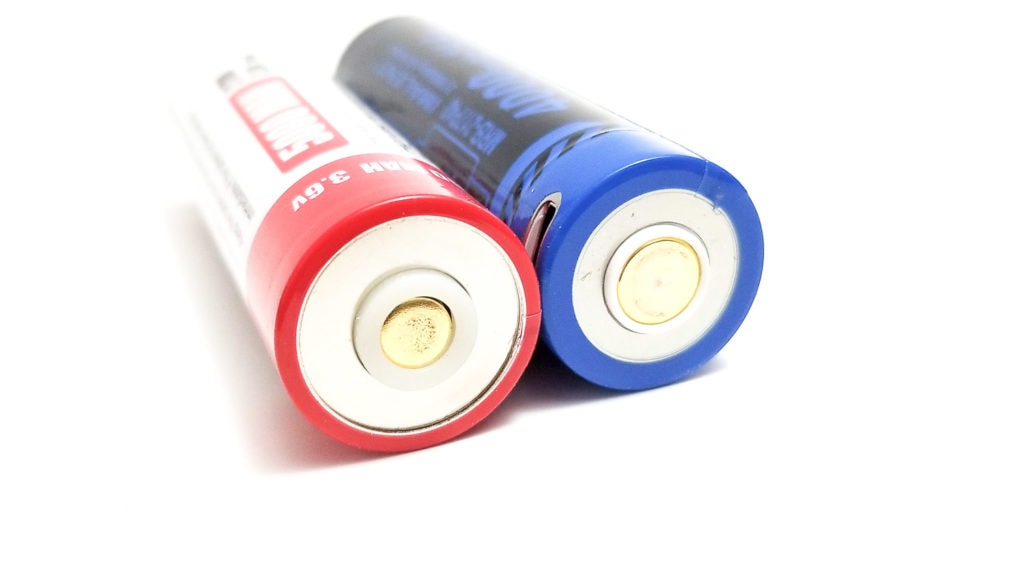
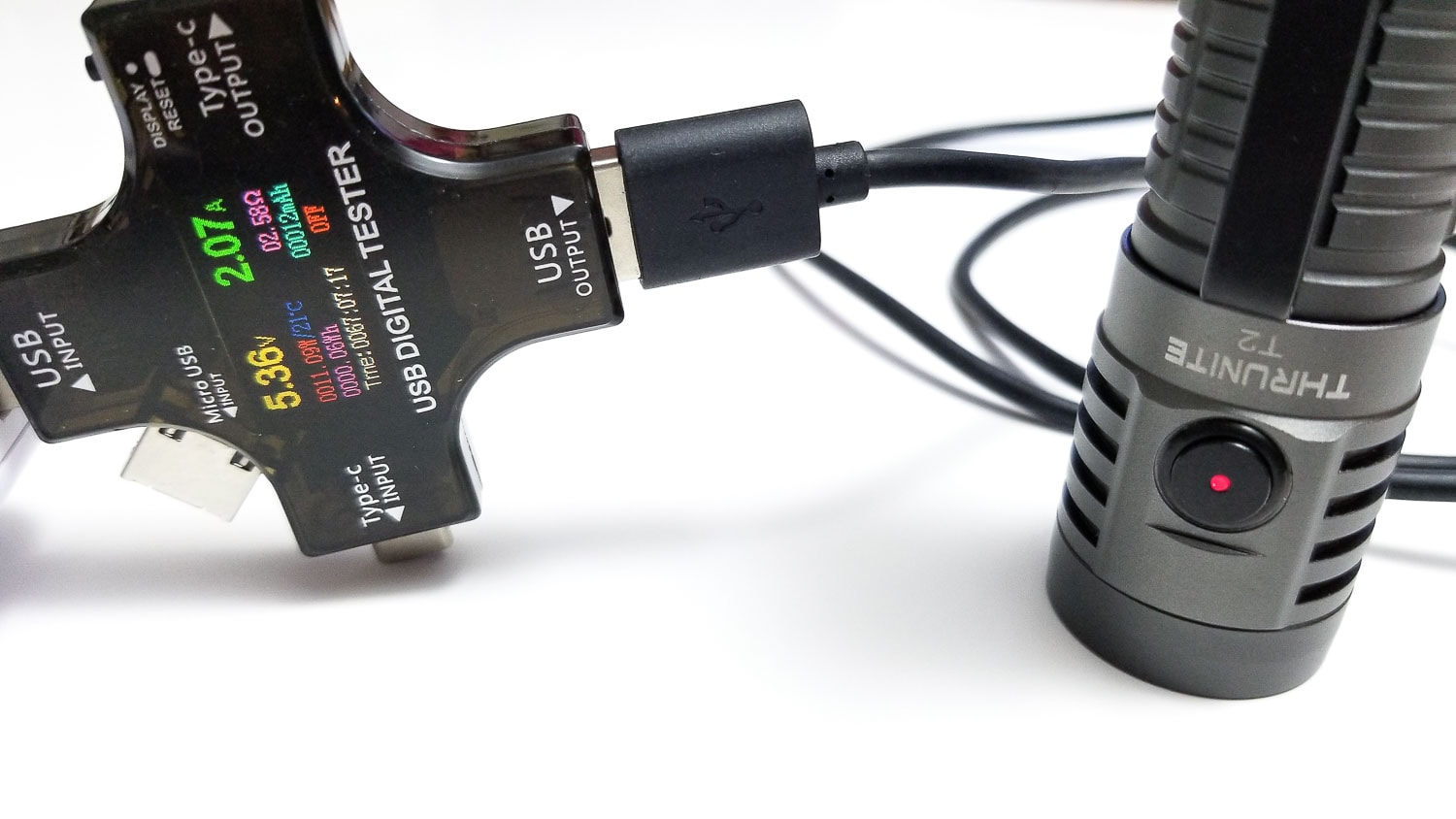
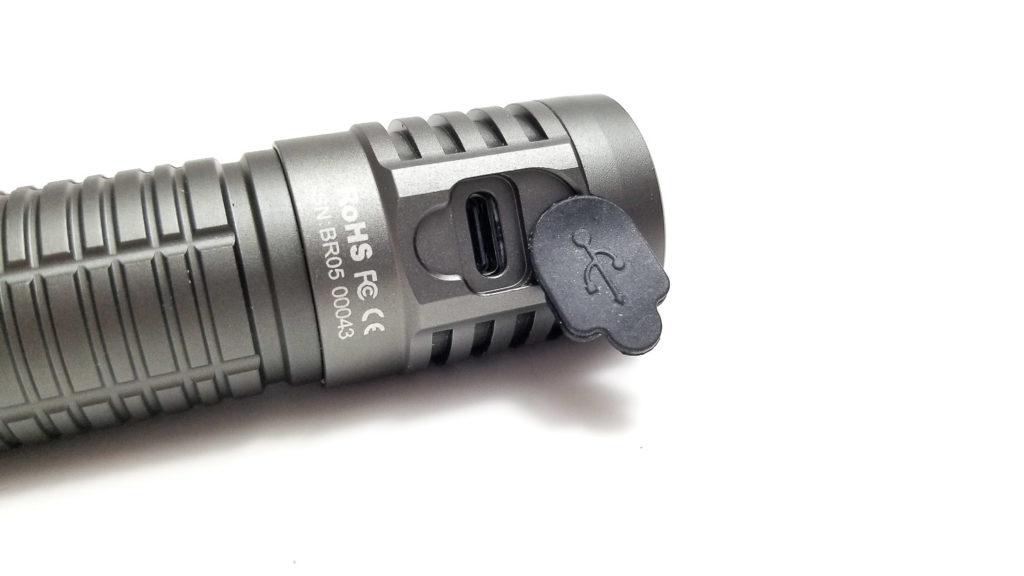
Performance test
Lumen measurements (for each mode)
Lumens were measured in the usual way using my home made 30 cm integrating sphere that’s been calibrated with several lights of known output including a Maukka-calibrated Convoy S2+. I use a Digi-Sense 20250-00 datalogging luxmeter. I used the included fully charged battery for the test. I usually measure amps using my Radio Shack T-RMS multimeter with 16 gauge wires inserted in the meter for currents under 8 amps, and my clamp meter with the loop of 12 gauge wire for over 8 amps. I used the included battery for the tests.
| Mode | Amps at start | Specs | turn on | 30 sec | 10 min |
|---|---|---|---|---|---|
| Firefly | 10 mA | 0.3 | N/A too low | N/A | N/A |
| Low | 50 mA | 30 | 29.88 lm | 29.88 lm | – |
| Med | 600 mA | 366 | 390 lm | 390 lm | 382 lm |
| High | 3.21 A | 1712 | 1751 lm | 1710 lm | 988 lm |
| Turbo | 10.1 A | 3757 lm | 2855 lm | 2722 lm | 830 lm |
The current figures are the input current to the battery and not the current to the LED since this is a boost driver. The Turbo figure is unimpressive and uncharacteristic for an XHP70.2. I ran the Turbo test twice and took the best result. I tried the battery out of the Imalent R30C (a rewrapped Samsung 40T), and got 3652 Lumens at start, which is a lot better. Thrunite, maybe include a stouter battery?
Parasitic drain:
- 1.3 µA
Runtime graph
I tested the light in my 30 cm integrating sphere calibrated using several lights including a Makkua S2+ with the Digi-Sense 20250-00 datalogging luxmeter with the included 5000 mAh battery. I tested Medium, High and Turbo mode.
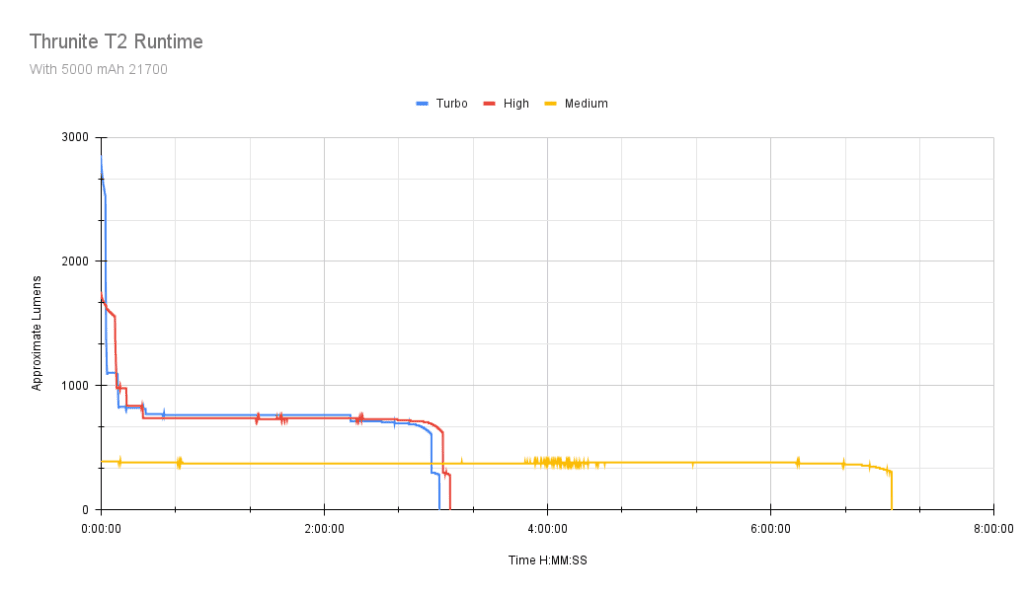

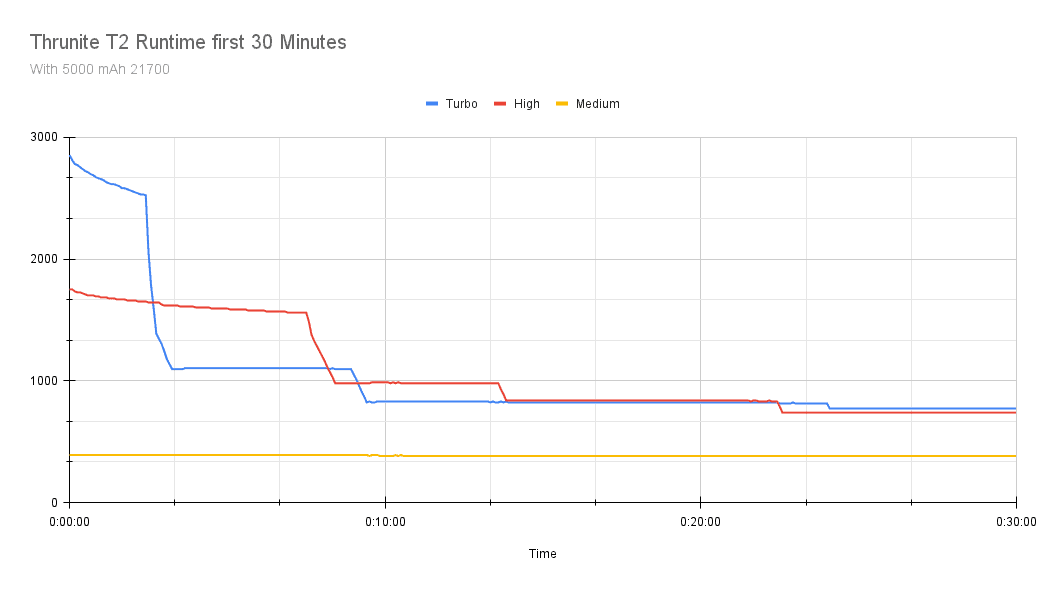
Turbo started way down from the advertised output at 2855 Lumens, and it was short-lived, only lasting for about 10 seconds before stepping down. However, the sustainability is pretty decent for a small light, making better than 2000 Lumens for over 2 minutes. It didn’t heat up as fast as I thought it would either. At 10 seconds it’s still 31 C, and by 50 seconds, it’s still under 50 C. Moreover, it’s hand-holdable for a great while: It wasn’t until 30 minutes in that the tube was uncomfortably warm, but not danger hot at around 45 C. Impressive! The light maintains 1000 Lumens or better for about 6 minutes, before gradual staged step downs until the 34 minute mark when the output settles around 700 Lumens and stays consistent for the next 2 hours. At 2 hours 57 minutes, the output drops under 300 Lumens, and 3 minutes later the light shuts down abruptly. Total runtime was 3 hours 1 minute. Thrunite’s spec for the Turbo runtime is 3 hours 38 minutes.
High mode started at 1751 Lumens, which for a small light like this is really good. Even better is the sustainability, managing more than 1700 Lumens for 45 seconds, more than 1600 Lumens for 4 minutes 25 seconds, and 1500 Lumens or more for another 3 minutes. There’s a timed stepdown at the (roughly) 4 minute mark as expected. It wasn’t until the 8 minute 20 second mark that the output dropped below 1000 Lumens. Impressive! Over the next 22 minutes, the output was over 800 Lumens, until stepping down to about 730, which it maintained for another 2 hours 34 minutes, before another drop to about 690 Lumens, then down to under 300 in a big drop at 3 hours 3 minutes, followed by a hard shut down 4 minutes later. Total runtime was 3 hours 7 minutes, down from the factory spec of 3 hours 46 minutes. Although the tube got pretty warm at 48 C, the light was pretty much hand-holdable the whole time, only reaching 54 C at the head 5 minutes into the test.
Medium was pretty uneventful (read: boring), so I let it run all day, and it happily chugged along, starting at 390 Lumens and not changing much over the entirety of the runtime. In fact, the difference at start versus shutdown is only 53 Lumens, which our eyes may not even notice. Either way, you’re getting better than 300 Lumens for 7 hours, 4 minutes. Thrunite says the runtime should be 7 hours 30 minutes. Impressive!
Thrunite once again proves why boost drivers, or any current-regulated drivers are awesome and I think worth the added cost. Fully regulated output is great for consistent brightness, and there’s no drama whatsoever with temperature and brightness fluctuations. The temperature regulation works great and the fact that the light was hand-holdable for a long time even on Turbo, was also great. I wasn’t impressed with the low output on Turbo though, and leads me to believe the battery might have been slightly under charged or just a bit weak, since it really woke up on the Imalent 40T. Still, plenty of very usable light to be had, and great runtimes.
Throw numbers:
I measured the throw with the Uni-T UT383S luxmeter indoors at 5 meters. I used the fully charged included battery. Measurements are recorded at 30 seconds.
| Mode | Specs | Candela measured | Meters | Yards |
|---|---|---|---|---|
| Firefly | – | N/A too low | N/A | N/A |
| Low | – | N/A too low | N/A | N/A |
| Medium | – | 775 cd | 55.67 | 60.88 |
| High | – | 3825 | 123.69 | 135.26 |
| Turbo | 6300 cd | 6075 cd (6425 at turn on) | 155.88 (160.31 at turn on) | 170.42 (175.31) |
Firefly and Low were too low to measure at 5 meters. Thrunite only lists a maximum candela figure (probably Turbo), and my figure for Turbo is a bit low at 30 seconds, but close at turn on. I didn’t expect the T2 to be a thrower, and it isn’t, but this is more than enough distance for EDC tasks.
Beamshots
- I compared the T2 to some other floody lights and some powerful pocket lights.
- Fireflies E07 2021 Edition (7x Cree XP-L HI V2 5D 6300 Lumens)
- Thrunite TC20 V2 (XHP70.2 4000 Lumens)
- Astrolux EA01 (TIR optic XHP50.2 3700 Lumens)
- Thrunite BSS V4 (SST70 2500 Lumens)
- Astrolux MF01 Mini (7x SST20 7300 Lumens
- C8 with FET driver (XHP50.2 3100 Lumens)
- Wuben C2 (SST40 2000 Lumens)
- Wuben D1 (XP-L 1100 Lumens)
Outdoor pictures: The fence is about 95 meters away. You can tell the T2 doesn’t throw as well as a larger-reflector TC20 V2, but still has plenty of throw for general purpose use.


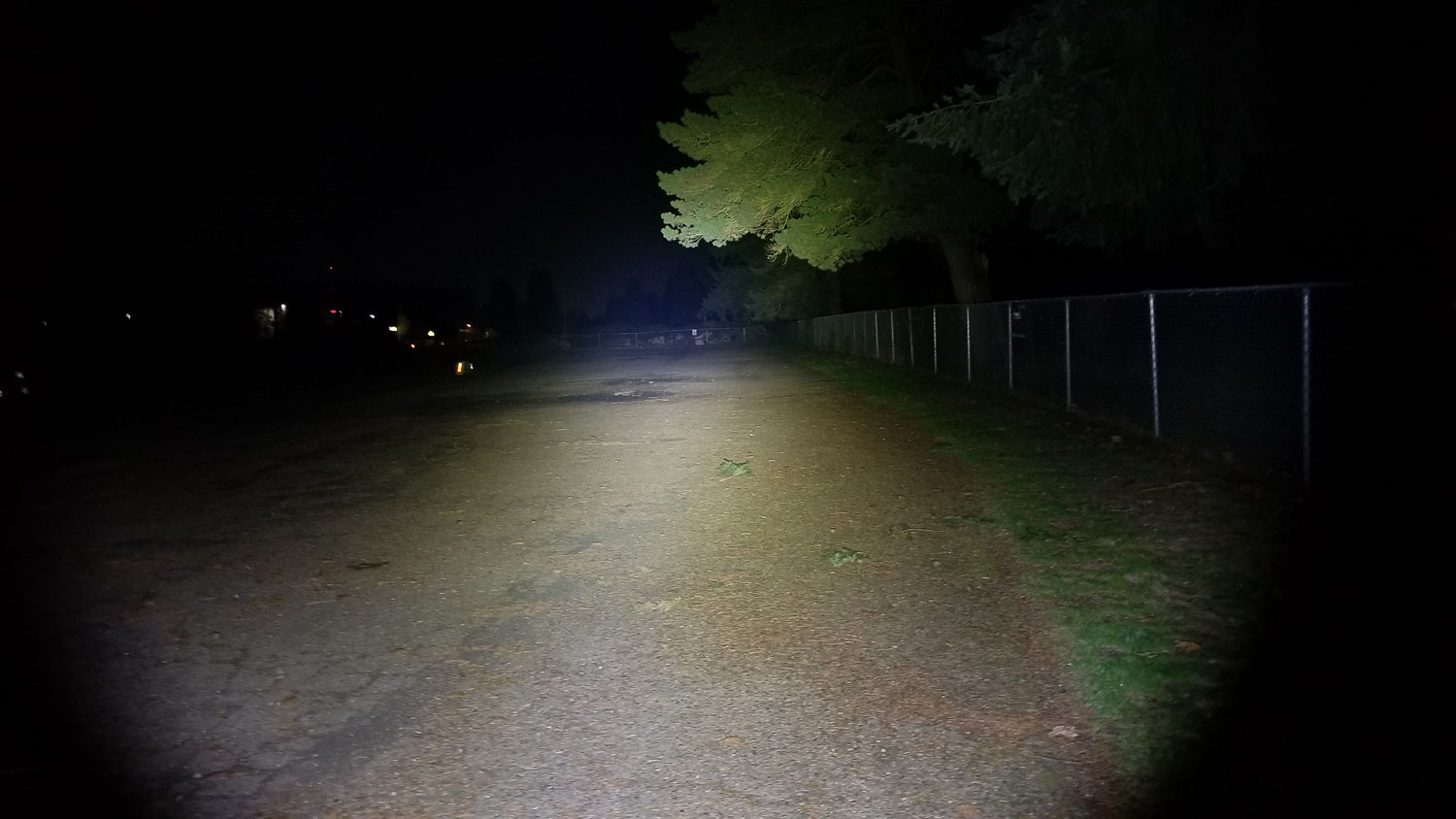



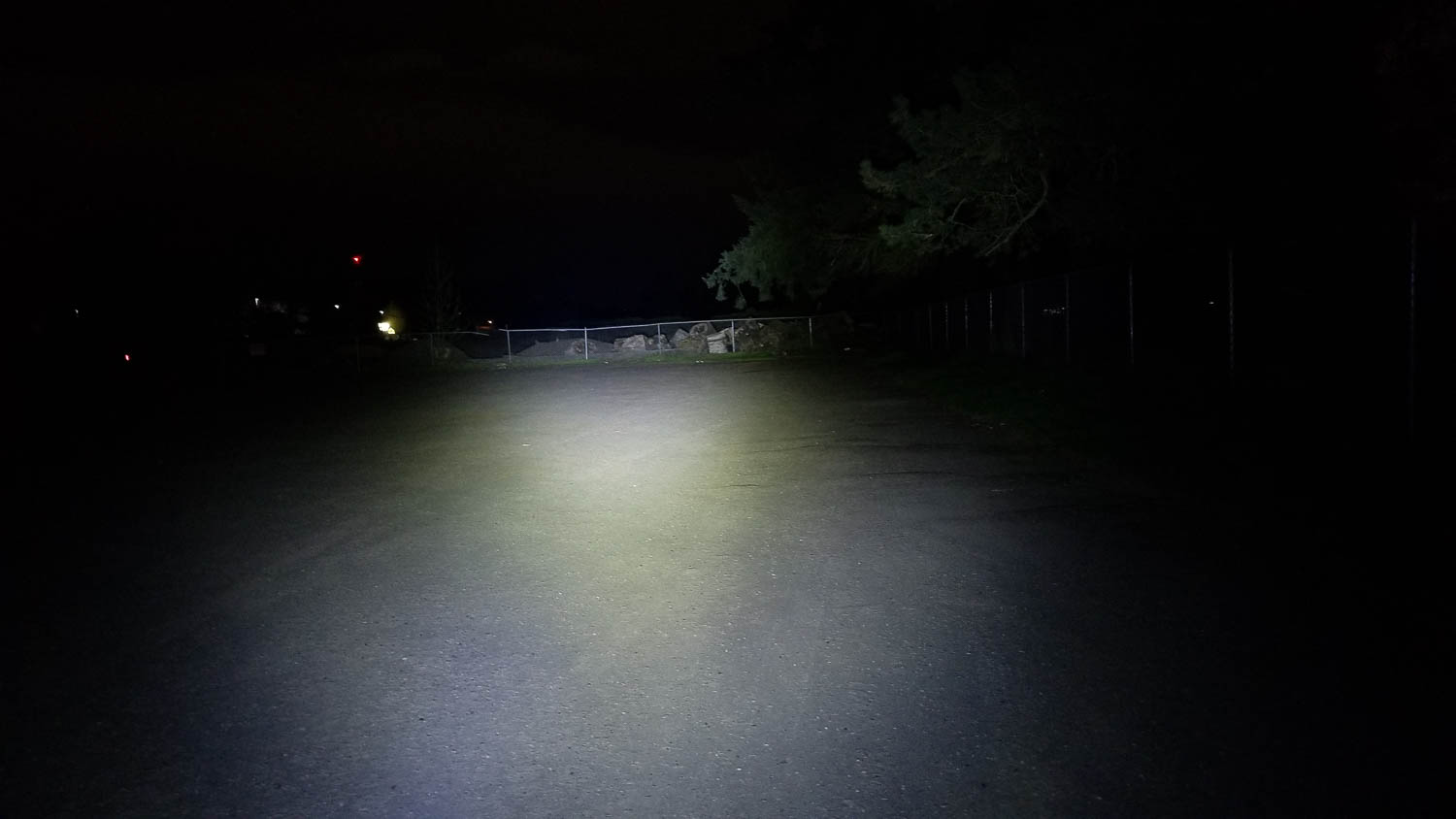


Disclaimer: This flashlight was sent to me for review at no cost by Thrunite. I have not been paid to review, nor have I been holding back on problems or defects.
Final Verdict
Pros
- Solid build quality
- Great value
- Compact and lightweight
- Well-regulated boost driver
- Long run times
- Quick charging
- Includes battery and all accessories
Cons
- Lanyard hole too small
- Abrupt shut down
- Turbo output way down from advertised
Explanation on star ratings:
1: Avoid: my phone flashlight would be a better choice – 2: Poor: significant defect or issues; almost unusable – 3: Average: some defects or issues; but still usable 4: Good: recommended (minor issues) – 5: Great: highly recommended

4.5 stars: ★★★★⋆
Once again, Thrunite has delivered an affordable, high-performing light that can wear a lot of hats: EDC? Sure. General purpose? Yep, good for that too. Nightstand duty? Why not? Going-on-a-walk flashlight? You bet! I had to really think about the competition because, well, there aren’t many pocket lights with an XHP70.2. Only the Acebeam E70 and Zebralight SC700d come close, and those are about double the price of the T2, and offer a lot of the same features. You can always grab a TC20 V2 if you want extra throw (and output) though. Choices!
Overall, I’m impressed with the balance of output and portability you get with the T2. It’s a good quality light as well, and cheaper than comparable Olight, Acebeam. You get a lot for the asking price, I like the small size, well regulated driver, and high-capacity 21700 battery when most lights this size are still sporting 18650s. The onboard charging is pretty quick, it handles well, and the UI is straightforward enough for anyone to master, and you get this in a kit (look Ma, no external charger or battery required!). The output is also really decent for the size, although not the 3700+ Lumens Thrunite advertises.
Now I know that proprietary batteries are a thing in consumer lights, and it’s a drag to be stuck with one, but the T2 is the exception to the rule here since you don’t have to use one in the T2. As an added bonus, the ‘proprietary’ battery works well in other (compatible) lights. Drawbacks? The beam is decidedly ugly (what, it’s a 70.2), I’d like to see a visual LVP notification, and the lanyard hole is too small. The Turbo output, while still plenty bright, is way down from advertised, and the T2 has garnered the honor of being the lowest-performing XHP70.2 light I’ve ever encountered. Besides that, I can’t really fault it much. The T2 is a solid XHP70.2 EDC and general purpose pocket light at a great price. 4.5 stars for the T2 and worth a look!
ThruNite T2 For Sale
1lumen selects and reviews products personally. We may earn affiliate commissions through our links, which help support our testing.